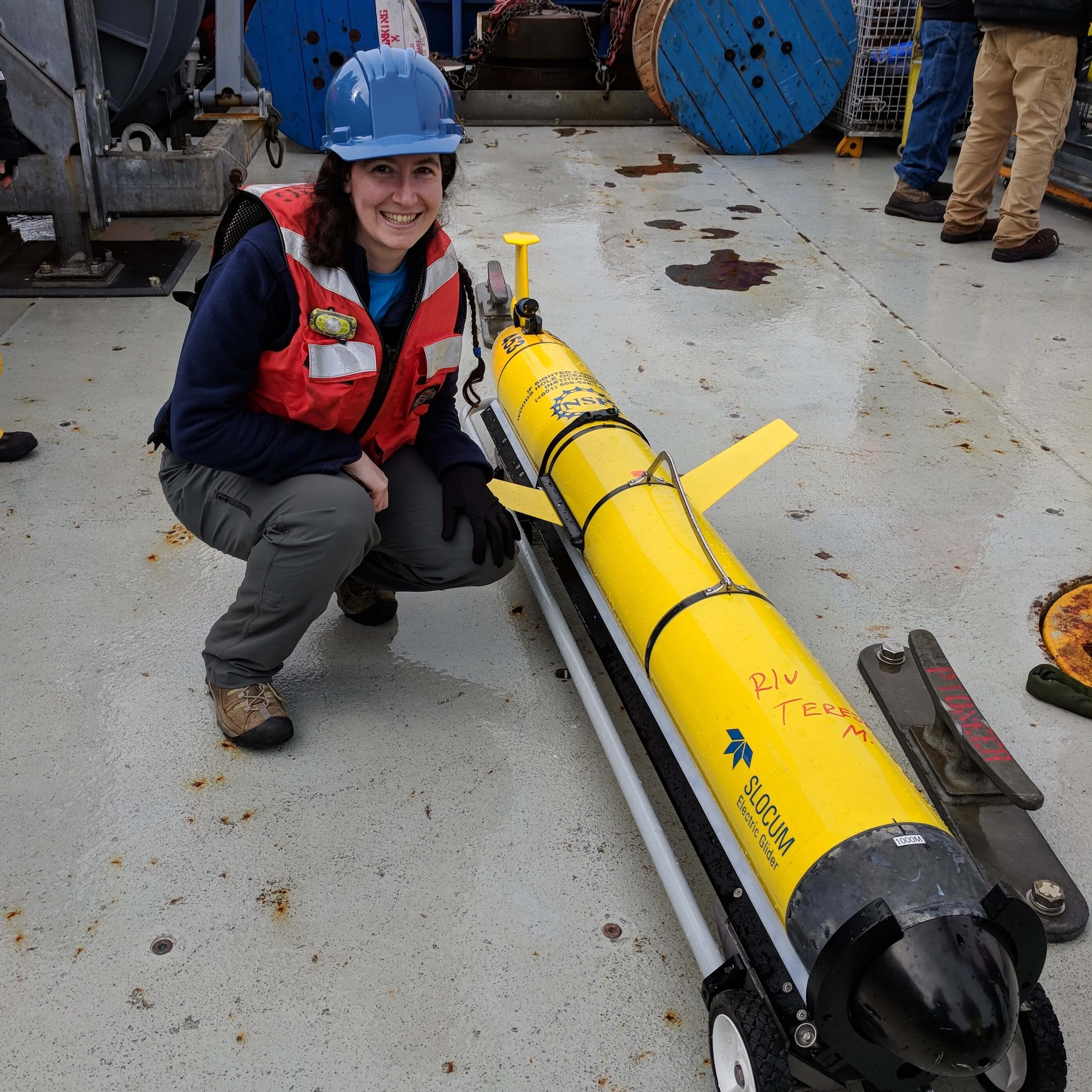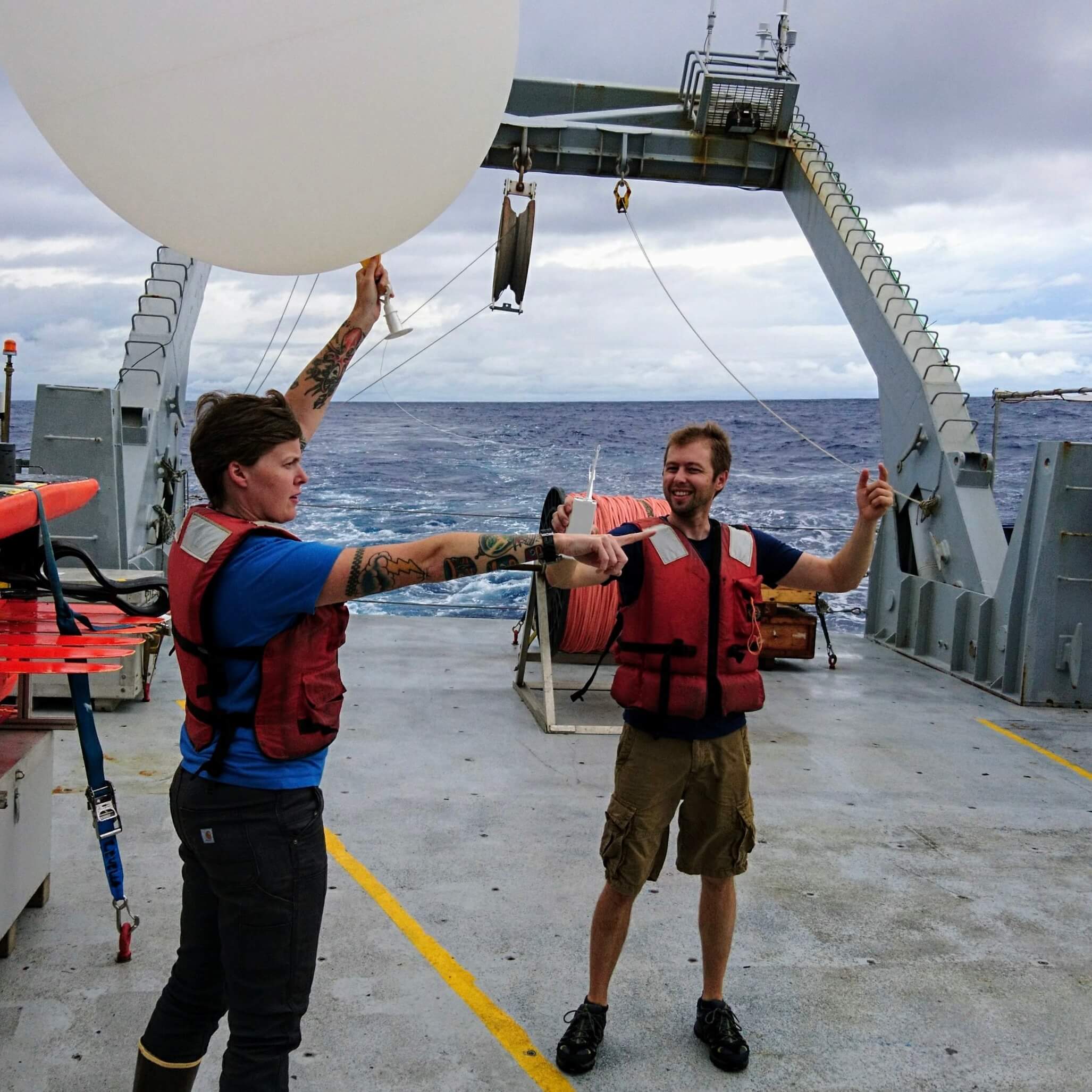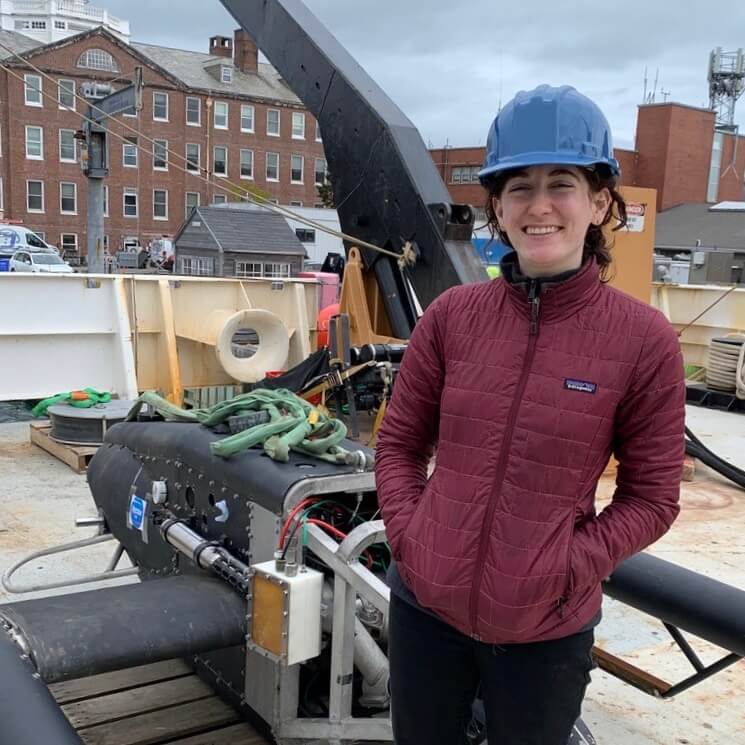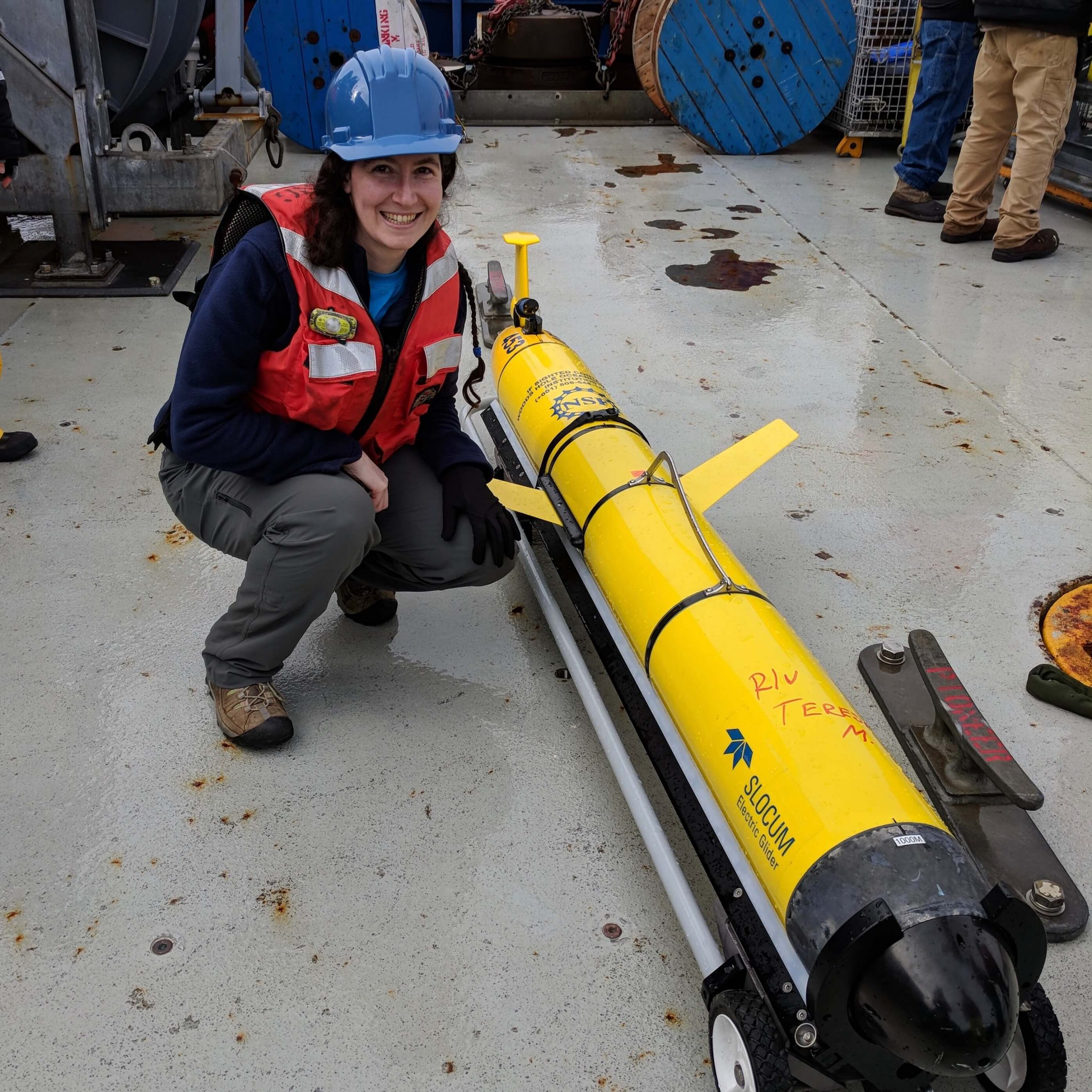Posts Tagged ‘International Women’s Day’
Hilary Palevsky: From landlocked to ocean expert, teacher, mentor
 Hilary Palevsky, Assistant Professor, Boston College[/caption]
Hilary Palevsky, Assistant Professor, Boston College[/caption]
Having grown up landlocked in Western Pennsylvania, Hilary Palevsky had never thought much about the ocean nor ever imagined studying oceanography. That all changed in her junior year of college when she participated in the Williams-Mystic Maritime Study Program. At the very beginning of the semester, she went to sea for 10 days aboard the Sea Education Association’s SSV Corwith Cramer. This experience turned out to be the perfect confluence of events for her future career path.
“I just fell in love with everything about the ocean – not only the science of it, but sea shanties, and maritime history and literature, “ explains Hilary. “I really wanted to do something about climate change. Realizing that the ocean plays this totally dominant role in the Earth’s climate system on human-relevant time scales, I knew that’s what I wanted to do.”
After graduating from Amherst College, she wasn’t sure what direction she would pursue but whatever it was, it would be ocean-related. Hilary took on a fellowship to study interactions between policy, science, and stakeholders through the lens of North Atlantic cod fisheries. She traveled all over the north Atlantic coast talking her way on to fisheries research vessels and small fishing boats. (As a 20-year-old woman, the former was easier than the latter). She also gave K-12 marine science education on traditionally-rigged schooners a try before she stepped on the path to getting a PhD in oceanography and a graduate certificate in climate science at the University of Washington.
Hilary is now an assistant professor at Boston College. Her research focuses on how the ocean takes up carbon dioxide from the atmosphere and the chemical, physical, and biological processes involved. A through line for her research are places that have strong seasonal cycles, which is how she came to work with OOI data. She was interested in getting measurements of how much carbon the ocean was taking up throughout the seasonal cycle in the subpolar North Atlantic. “There is a really interesting and exciting interplay between biological processes – a huge spring bloom in the North Atlantic—and physical processes, where there’s really deep winter mixing.” To understand how these two interact requires having measurements throughout the year. OOI makes this possible by continuously collecting this data, including times when it’s too cold and stormy to be out there on a boat.
Mentoring makes a difference
A major part of Hilary’s professional life now revolves around teaching. She is one of those exceptional teachers who makes science accessible and interesting. Hilary is also one heck of a mentor.
“My understanding of mentorship and role modeling have changed over time. I didn’t feel like the gender identity of my mentors mattered to me [as an undergraduate] because I had awesome women mentors. I had a great undergraduate senior research advisor, for example, who modeled other things [than just research] for me. She was married to another woman, I met and got to know her wife. From her, I learned how to figure out how to be a person doing science rather than a scientist trying to be a person.” Hilary actually met her spouse for the first time in her advisor’s office!
Having such mentoring and role model representation early on in her career were particularly important to Hilary as a woman and a queer person. She didn’t experience the barriers that often exist because she had role models who demonstrated how she could survive and thrive in the scientific academic community.
“It was only later on in my career, when all of my advisors were straight men, that I recognized that there was really something important about my early mentors. But today I also recognize that all of my mentors have provided important things along the way. I have had male mentors who have been great role models for me as a woman. I’ve had straight mentors who have supported me as a queer woman with a spouse who is transgender.”
Hilary’s experiences have made her adamant about the importance of being a good mentor, particularly for people who don’t share the same identities. “I think about myself as a white woman who now mentors undergraduate and graduate students in a field that is overwhelmingly white. I constantly ask myself what do I have to do to be an effective mentor to students of color and coming from backgrounds and identities that are different from mine?”
Until a truly inclusive and diverse science community exists, Hilary believes it is imperative that leaders in academia find ways to be effective mentors for people who don’t either look like them or share some or all of their identities. “While the Geosciences has made some progress in gender parity, the representation of people of color has not made the same gains. The fact that I as a white woman have a faculty position shows there’s been progress, but we have to start making this happen for Black women, Indigenous women, trans women, all of whom haven’t been making these same gains as white women.”
Profiles of Other Exceptional OOI Women
[caption id="attachment_20422" align="alignnone" width="300"] Sophie Clayton, Assistant Professor, Old Dominion University[/caption]
[caption id="attachment_20424" align="alignleft" width="300"]
Sophie Clayton, Assistant Professor, Old Dominion University[/caption]
[caption id="attachment_20424" align="alignleft" width="300"] Hilde Oliver, Postdoctoral Scholar, Woods Hole Oceanographic Institution[/caption]
Hilde Oliver, Postdoctoral Scholar, Woods Hole Oceanographic Institution[/caption]
Read More
Sophie Clayton: Curious, Creative, with an Irrepressible Desire to Understand Connections
 Sophie Clayton, Assistant Professor, Old Dominion University[/caption]
Sophie Clayton, Assistant Professor, Old Dominion University[/caption]
Sophie Clayton learned how to swim before she could walk. She spent her early years with her family exploring beaches during summer vacations in the south of France. Her fascination with being in and around the water never waned. Her dad finally relented and bought Sophie her first pair of diving fins when she was seven, even though he thought her curiosity might sweep her away!
Early on, Sophie excelled in math and science, but a move to Scotland at age 16 started her on a new track. Her first stint at higher education landed her in art school, where she majored in fine art, photography her primary medium. After graduating, uncertain of her next steps, she took a gap year in Australia. There, too, the water called her name.
A SCUBA diving course north of Sydney, put her on track to become a divemaster and then a diving instructor. She went on to teach diving on the Great Barrier Reef and in the Maldives, spending seven days a week in the water for the better part of three years.
One day it dawned on Sophie that she needed to better understand the environment in which she had surrounded herself. She decided to become an oceanographer. She headed back to the UK, north west Wales in fact, offering quite a different environment than the tropics, where she earned a degree in oceanography.
From there, the path was rapid and clear—mostly. In 2006 she landed a Research Experience for Undergraduates (REU) spot at Woods Hole Oceanographic Institution (WHOI) advised by physical oceanographer Prof. Annelisa Bracco. She was admitted to the WHOI/MIT Joint Program in oceanography the following year and earned her PhD in Physical Oceanography. After a postdoctoral stint at the University of Washington, Sophie returned to the East coast to join the Ocean and Earth Sciences faculty at Old Dominion University as an Assistant Professor
Always an artist
“I seem to have come full circle from my art school days. Now I’m working with imaging instruments, studying phytoplankton. I get a lot of people asking me: aren’t art and science really different and don’t you feel like art school was a waste? My answer is always ‘Absolutely not!’ I use a lot of my in art school training—independent study and researching around a topic—we were taught to explore ideas and approach them from every angle. I apply the same thought processes to my science now. The difference is the toolkit.”
Sophie excels in making connections, which are not always obvious. While trained in physical oceanography, she studies the interactions between the ocean biology, biogeochemistry, and physics. As a result, she pulls lots of the pieces together in a system to see how they all work in concert. The question she is now exploring is how ocean circulation features, especially fronts and eddies, shape phytoplankton communities. She strives to answer this question by looking at the big picture: the impact of how much light they get, the supply of nutrients, what happens when mixing communities from different places together.
Mentors and Networking
When asked about who helped mentor her along the way, Sophie responded that “lots of people have.” She called out Prof. David Bowers, a physical oceanographer who advised her during her undergraduate studies in the UK, Prof. Annelisa Bracco, her WHOI REU mentor, and Prof. Mick Follows, her graduate advisor at MIT, for their support and guidance at important transitions in her life, but said that many others have helped her on her circuitous path.
“As a grad student, I made a point of going to talk to people about their research and to discuss my work and ideas. I have been really lucky to have built relationships that have come about from these conversations and keeping in touch over the years.” She views her mentors as a combination of senior people, both men and women, who have helped her in her career, and her peers, who have provided practical advice on advancing her science, teaching, and life. “Senior women in particular have shown me what’s possible and served as examples of how it is done.”
When asked for counsel for other women considering careers in science, Sophie suggests taking the time to find the right graduate and post doc advisors. “These folks have a tremendous impact on our lives and our future, so it’s important to take the time to make sure that they are a good fit and you will work well together.” Her other words of advice are “talk to people, chatting about your science is important and you’ll be surprised at not only what you learn but the connections you will make.”
Profiles of Other Exceptional OOI Women
[caption id="attachment_20424" align="alignnone" width="300"] Hilde Oliver, Postdoctoral Scholar, Woods Hole Oceanographic Institution[/caption]
[caption id="attachment_20423" align="alignnone" width="300"]
Hilde Oliver, Postdoctoral Scholar, Woods Hole Oceanographic Institution[/caption]
[caption id="attachment_20423" align="alignnone" width="300"] Hilary Palevsky, Assistant Professor, Boston College[/caption]
Hilary Palevsky, Assistant Professor, Boston College[/caption]
Read More
Hilde Oliver: Carrying on the tradition of smart, educated women
 HIlde Oliver, Postdoctoral Scholar, Woods Hole Oceanographic Institution[/caption]
HIlde Oliver, Postdoctoral Scholar, Woods Hole Oceanographic Institution[/caption]
Hilde Oliver, an oceanographer studying biophysical interactions and a Woods Hole Oceanographic Institution (WHOI) Postdoctoral Scholar, comes from a long line of educated women. Both her grandmother and her mother have PhDs in science, so Hilde is a third-generation woman in science.
“I come from an environment where women were strongly encouraged to pursue science. Not only did my grandmother and mother serve as role models growing up, but they were also always fully supportive of me doing this type of work,” said Hilde.
Midway through her pursuit of her PhD in marine sciences, Hilde was surprised to learn that her grandmother had initially been interested in studying oceanography herself but ended up studying biology. “It was a time when women weren’t encouraged to do that type of work and weren’t really wanted in ship environments. It was interesting to learn that we had similar interests.”
Hilde also attributes her predilection toward the sciences due to living in the small city of Oak Ridge, TN, home of Oak Ridge National Laboratory and a community oriented toward math and science. Growing up there instilled in her a “love for all things math and science.” Her interests ran the gamut from biology, chemistry, physics, and math.
During her freshman year, settling in as a math major at the University of South Carolina, Hilde took an Honors Ecology and Evolution class. During this class, she learned how to apply simple differential equations to fundamental predator-prey interactions—knowledge that launched her trajectory as an ocean ecosystem modeler. Hilde went on to earn her PhD from the University of Georgia and headed north to Woods Hole Oceanographic Institution for a postdoc position with Dennis McGillicuddy and Gordon Zhang.
Studying plankton with models and observations
At WHOI, Hilde is investigating how changing large-scale circulation influences phytoplankton growth in the Mid-Atlantic Bight. She is adding observational work to her modeling efforts using OOI glider data. “I thoroughly enjoy working at WHOI, where OOI is managed and operated. It is so exciting to be working in the environment where people are developing and deploying the instrumentation I’m applying in my research.” OOIs physical and biogeochemical datasets have allowed her to study biophysical interactions near the New England shelfbreak as a part of the larger NSF-funded Shelfbreak Productivity Interdisciplinary Research Operation at the Pioneer Array (SPIROPA) project.
Hilde also recently spent 60 days aboard the global-class research vessel R/V Roger Revelle with a team operating a towed underwater microscope system, the Video Plankton Recorder. The scientific team headed to the Pacific sector of the Southern Ocean to assess the chemical and biological conditioning of Subantarctic Mode Water, which is formed north of the Antarctic Circumpolar Current. The team was in search of coccolithophores, phytoplankton that form calcium carbonate shells.
Due to covid restrictions, the team was forced to depart from Honolulu, traveling all the way from 21° North to 60° South. The length of the transit to the research site nearly doubled their time at sea. This long transit left the team with only 32 days to conduct their research, which they used to full advantage, including finding coccolithophores.
A solid foundation of support
Many have played pivotal roles in Hilde’s path to the sciences. In addition to her family legacy, Hilde’s PhD advisor, Patricia Yager, was hugely instrumental in encouraging Hilde as a woman in science. Yager taught her the ins and outs of being a female scientist in a field once dominated by men while encouraging Hilde to pursue her own ideas.
“Tish (Patricia) instilled in me the confidence to become independent in my thinking,” she explained. “And, for any early-career person developing that independence is critical. So I am very grateful to her for that.”
Hilde offers that two takeaways from her positive relationship with Yager: “It’s important to work with people you want to work with, particularly during your PhD, for you are signing on for five or more years, a long time if it’s not a good fit. Also, it’s vital to develop a working relationship based on mutual respect so that everyone can positively benefit from the time spent together.”
With these tenets in mind, Hilde hopes to one day build a research program of her own that is highly interdisciplinary, takes advantage of the variety of datasets and tools available, and serves to help early-career scientists advance their own research ideas to their fullest expression.
Profiles of Other Exceptional OOI Women
[caption id="attachment_20423" align="alignnone" width="300"] Hilary Palevsky, Assistant Professor, Boston College[/caption]
[caption id="attachment_20422" align="alignnone" width="300"]
Hilary Palevsky, Assistant Professor, Boston College[/caption]
[caption id="attachment_20422" align="alignnone" width="300"] Sophie Clayton, Assistant Professor, Old Dominion University[/caption]
Read More
Sophie Clayton, Assistant Professor, Old Dominion University[/caption]
Read More 
